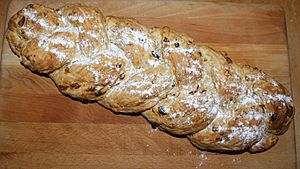Allerheiligenstriezel facts for kids
 |
|
| Alternative names | Strietzel, Allerseelenzopf, Allerseelenbreze, Seelenspitze, Seelenbrot |
|---|---|
| Type | Pastry |
| Place of origin | Austria, Germany (Bavaria) |
| Main ingredients | Flour, eggs, yeast, shortening or butter, raisins, milk |
Allerheiligenstriezel is a special braided pastry from Austria and Germany. Its name means "All Saints' braid" in English. People also call it Strietzel or by other regional names like Allerseelenzopf.
This yummy pastry is made from a soft dough. Key ingredients include flour, eggs, yeast, and milk. It also has shortening or butter, raisins, salt, and decorating sugar or poppy seeds on top. Some recipes even add lemon juice for extra flavor.
The word Strietzel comes from old German words like strutzel. Its exact origin is a bit of a mystery!
Contents
The History of Allerheiligenstriezel
When Was Striezel First Made?
The first time we know about Striezel was in a book from Saxen, Upper Austria. This was a long time ago. Back then, it was called Heiligenstriezel.
How Striezel Changed Over Time
Early versions of this bread were quite simple. They were not braided and used a basic dough with wheat, eggs, fat, and honey. Later, people started making more complex braided loaves. These fancy braids became a popular tradition.
In 1840, a newspaper called Der Österreichische Zuschauer wrote about a custom in Vienna. People would give each other braided loaves on All Saints' Day. This shows how important the pastry had become. By 1929, making different types of braids was even part of the official Baker's Master Examination in Upper Austria!
Allerheiligenstriezel Traditions
Gifts for Godchildren
In Austria and Bavaria, Allerheiligenstriezel is often given as a gift. Godfathers traditionally give it to their godchildren for All Saints' Day. This custom has old roots, linked to ancient ways of showing sadness. Braided hair was a symbol of mourning. The braided pastry might have become a symbol of this.
A Treat for Everyone
In the 19th century, it was common to give this rich cake to people who were poor. An Austrian writer named Peter Rosegger wrote about this. For children in the countryside, getting a Striezel was a special treat. It helped make up for times when food was scarce.
Good Luck Superstitions
In some places, especially in Linz, people had a fun belief about Striezel. They thought that the luck for the coming year depended on how well the pastry turned out! If the yeast didn't work and the dough didn't rise, some believed it meant bad luck.
Striezel in Dresden
In Dresden, a city in Germany, a similar cake is now usually called Dresdner [Christ]stollen. This Stollen is an unbraided German cake. However, it used to be called Dresdner Striezel. The famous Dresdner Striezelmarkt (Dresden Striezel Market) got its name from this cake back in 1434. Even today, a cake called Dresdner Striezel is baked in Dresden as a special Christmas treat.


